Selected publications:
Wetting Effects in Hair Simulation, Pacific Graphics, 2012, Hong Kong.
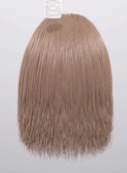
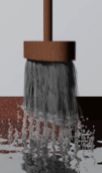
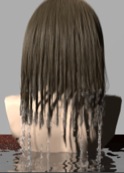
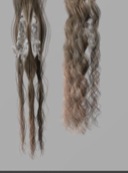
There is considerable recent progress in hair simulations, driven by the high demands in computer animated movies. However, capturing the complex interactions between hair and water is still relatively in its infancy. Such interactions are best modeled as those between water and an anisotropic permeable medium as water can flow into and out of the hair volume biased in hair fiber direction. Modeling the interaction is further challenged when the hair is allowed to move. In this paper, we introduce a simulation model that reproduces interactions between water and hair as a dynamic anisotropic permeable material. We utilize an Eulerian approach for capturing the microscopic porosity of hair and handle the wetting effects using a Cartesian bounding grid. A Lagrangian approach is used to simulate every single hair strand including interactions with each other, yielding fine-detailed dynamic hair simulation. Our model and simulation generate many interesting effects of interactions between fine-detailed dynamic hair and water, i.e., water absorption and diffusion, cohesion of wet hair strands, water flow within the hair volume, water dripping from the wet hair strands and morphological shape transformations of wet hair.
[PDF][*Click an image for its corresponding video*][Dry & wet hair comparison][Method overview]
Twisting, Tearing and Flicking Effects in String Animations, Motion in Games, 2011, Edinburgh, UK.
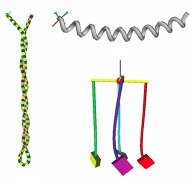

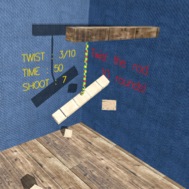
String-like objects in our daily lives including shoelaces, threads and rubber cords exhibit interesting behaviors such as twisting, tearing and bouncing back when pulled and released. In this paper, we present a method that enables these behaviors in traditional string simulation methods that explicitly represent a string by particles and segments. We offer the following three contributions. First, we introduce a method for handling twisting effects with both uniform and non-uniform torsional rigidities. Second, we propose a method for estimating the tension acting in inextensible objects in order to reproduce tearing and flicking (bouncing back); whereas the tension for an extensible object can be easily computed via its stretched length, the length of an inextensible object is maintained constant in general, and thus we need a novel approach. Third, we introduce an optimized grid-based collision detection for an efficient computation of collisions. We demonstrate that our method allows visually plausible animations of string-like objects made of various materials and is a fast framework for interactive applications such as games.
[PDF] [VIDEO] [Extra1] [Extra2]
Chain Shape Matching for Simulating Complex Hairstyles, Computer Graphics Forum, 2010
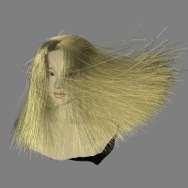
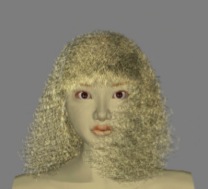
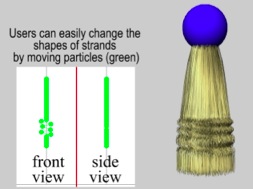
Animations of hair dynamics greatly enrich the visual attractiveness of human characters. Traditional simulation techniques handle hair as clumps or continuum for efficiency; however, the visual quality is limited because they cannot represent the fine-scale motion of individual hair strands. Although a recent mass-spring approach tackled the problem of simulating the dynamics of every strand of hair, it required a complicated setting of springs and suffered from high computational cost. In this paper, we base the animation of hair on such a fine-scale on Lattice Shape Matching (LSM), which has been successfully used for simulating deformable objects. Our method regards each strand of hair as a chain of particles, and computes geometrically derived forces for the chain based on shape matching. Each chain of particles is simulated as an individual strand of hair. Our method can easily handle complex hairstyles such as curly or afro styles in a numerically stable way. While our method is not physically based, our GPU-based simulator achieves visually plausible animations consisting of several tens of thousands of hair strands at interactive rates.
[PDF] [VIDEO] [Extra1] [Extra2]
Real-time Animation of Sand-Water Interaction, Pacific Graphics 2008, Tokyo, Japan.
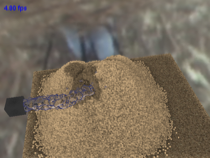
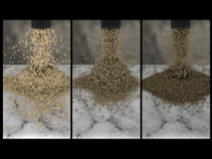
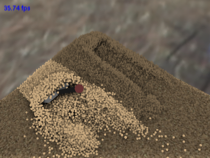
Recent advances in physically-based simulations have made it possible to generate realistic animations. However, in the case of solid-fluid coupling, wetting effects have rarely been noticed despite their visual importance especially in interactions between fluids and granular materials. This paper presents a simple particle-based method to model the physical mechanism of wetness propagating through granular materials; Fluid particles are absorbed in the spaces between the granular particles and these wetted granular particles then stick together due to liquid bridges that are caused by surface tension and which will subsequently disappear when over-wetting occurs. Our method can handle these phenomena by introducing a wetness value for each granular particle and by integrating those aspects of behavior that are dependent on wetness into the simulation framework. Using this method, a GPU-based simulator can achieve highly dynamic animations that include wetting effects in real time.
[PDF] [VIDEO] [PG2008 Opening movie]
